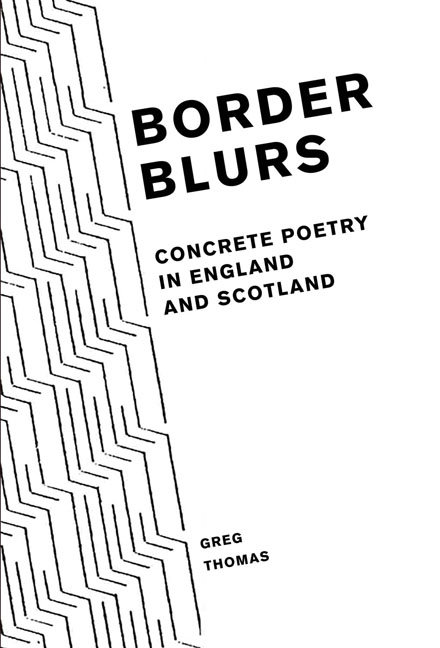Book contents
- Frontmatter
- Contents
- Dedication
- Figures
- Notes on Referencing
- Acknowledgements
- 1 Introduction
- 2 Concrete Poetry/Konkrete Poesie/Poesia Concreta: The International Scene
- 3 Order and Doubt: Ian Hamilton Finlay
- 4 Off-Concrete: Edwin Morgan
- 5 Apophasis: Dom Sylvester Houédard
- 6 Abstract Concrete: Bob Cobbing
- 7 ?Concrete Poetry and After: Conclusion
- Works Cited
- Index
1 - Introduction
- Frontmatter
- Contents
- Dedication
- Figures
- Notes on Referencing
- Acknowledgements
- 1 Introduction
- 2 Concrete Poetry/Konkrete Poesie/Poesia Concreta: The International Scene
- 3 Order and Doubt: Ian Hamilton Finlay
- 4 Off-Concrete: Edwin Morgan
- 5 Apophasis: Dom Sylvester Houédard
- 6 Abstract Concrete: Bob Cobbing
- 7 ?Concrete Poetry and After: Conclusion
- Works Cited
- Index
Summary
This book is about the practice of concrete poetry in England and Scotland during the 1960s and early 1970s. Concrete poetry was an international literary and artistic style developed largely during the 1950s–1970s, defined at the most basic level by its focus on the visual, sonic, and otherwise formal or material elements of language. It shared that concern, of course, with other styles and movements that might similarly be called modernist, but is unique among those styles in various respects, not least in its practice long after the early twentieth-century heyday of the self-defining Western modernist vanguard, often in areas of the world – and areas of Britain – only tangentially or belatedly broached by earlier waves of modernist and avant-garde activity. In these new contexts, concrete poetry turned pre-defined impulses towards the merging of artistic media to new ends in response to a gamut of new artistic, cultural, and social contexts: from the mid-century flowering of modernist aesthetics in the worlds of architecture and design to the enveloping swath of literary and artistic activity – including conceptual, intermedia, and pop art, cut-up, Lettrist, and sound poetry, aleatoric musical scores, abstract expressionist painting, and artists’ books – refocusing attention on interactions between the linguistic, visual, and sonic planes; from a post-war emphasis on rebuilding international relations through forms of globally coherent communication to the unravelling of medium boundaries in sixties art as a revolt against socially mediated psychology; and from the emergence of computer coding and associated discourses around cybernetics and information theory – which presented both a challenge and an opportunity for poetic language – to prophecies of a dawning ‘electric’ age in which the hypnotic grammars of mass media would have to be simultaneously or ‘spatially’ processed (McLuhan 1962). The list could go on, and yet, despite these myriad points of interest, concrete poetry has, until relatively recently, been most conspicuously distinguished from its modernist predecessors by its long-term failure to earn serious literary-critical attention.
This may partly reflect the very diversity of thematic associations and analogies – like those just listed – that concrete poetry has been able to support, which make it somewhat difficult to process conceptually in retrospect.
- Type
- Chapter
- Information
- Border BlursConcrete Poetry in England and Scotland, pp. 1 - 18Publisher: Liverpool University PressPrint publication year: 2019



